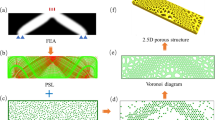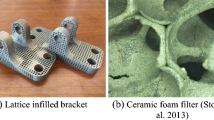Abstract
Porous structures widely exist in nature and artifacts, which can be exploited to reduce structural weight and material usage or improve damage tolerance and energy absorption. In this study, the authors develop an approach to design optimized porous structures with Triply Periodic Minimal Surfaces (TPMSs) in the framework of isogeometric analysis (IGA)-based topological optimization. In the developed method, by controlling the density distribution, the designed porous structures can achieve the optimal mechanical performance without increasing the usage of materials. First, the implicit functions of the TPMSs are adopted to design several types of porous elements parametrically. Second, to reduce the cost of computation, the authors propose an equivalent method to forecast the elastic modulus of these porous elements with different densities. Subsequently, the relationships of different porous elements between the elastic modulus and the relative density are constructed. Third, the IGA-based porous topological optimization is developed to obtain an optimal density distribution, which solves a volume constrained compliance minimization problem based on IGA. Finally, an optimum heterogeneous porous structure is generated based on the optimized density distribution. Experimental results demonstrate the effectiveness and efficiency of the proposed method.
Similar content being viewed by others
References
Elnasri I, Pattofatto S, Zhao H, et al., Shock enhancement of cellular structures under impact loading: Part I experiments, Journal of the Mechanics and Physics of Solids, 2007, 55(12): 2652–2671.
Andrews E W and Gibson L J, The influence of cracks, notches and holes on the tensile strength of cellular solids, Acta Materialia, 2001, 49(15): 2975–2979.
Ajdari A, Nayeb-Hashemi H, and Vaziri A, Dynamic crushing and energy absorption of regular, irregular and functionally graded cellular structures, International Journal of Solids & Structures, 2011, 48(3–4): 506–516.
Wu S L, Liu X M, Yeung K W K, et al., Biomimetic porous scaffolds for bone tissue engineering, Materials Science and Engineering: R: Reports, 2014, 80: 1–36.
Chen Y Z, Zhang R, Jiao L, et al., Metal-organic framework-derived porous materials for catalysis, Coordination Chemistry Reviews, 2018, 362: 1–23.
Ajit P, Meisam A, Duncan H, et al., Strategies for functionally graded lattice structures derived using topology optimisation for Additive Manufacturing, Additive Manufacturing, 2018, 19: 81–94.
Cheah C M, Chua C K, Leong K F, et al., Development of a tissue engineering scaffold structure library for rapid prototyping. Part 1: Investigation and classification, International Journal of Advanced Manufacturing Technology, 2003, 21(4): 291–301.
Sun W, Starly B, Darling A, et al., Computer-aided tissue engineering: Application to biomimetic modelling and design of tissue scaffolds, Biotechnology and Applied Biochemistry, 2004, 39(1): 49–58.
Rajagopalan S and Robb R A, Schwarz meets Schwann: Design and fabrication of biomorphic tissue engineering scaffolds, Medical Image Analysis, 2006, 10(5): 693–712.
Schroeder C, Regli W C, Shokoufandeh A, et al., Computer-aided design of porous artifacts, Computer-Aided Design, 2005, 37(3): 339–353.
Sogutlu S and Koc B, Stochastic modeling of tissue engineering scaffolds with varying porosity levels, Computer-Aided Design and Applications, 2007, 4(5): 661–670.
Kou X Y and Tan S T, A simple and effective geometric representation for irregular porous structure modeling, Computer-Aided Design, 2010, 42(10): 930–941.
Li M, Zhu L C, Li J Z, et al., Design optimization of interconnected porous structures using extended triply periodic minimal surfaces, Journal of Computational Physics, 2021, 425: 109909.
Yoo D J, Porous scaffold design using the distance field and triply periodic minimal surface models, Biomaterials, 2011, 32(31): 7741–7754.
Yang N, Quan Z, Zhang D W, et al., Multi-morphology transition hybridization cad design of minimal surface porous structures for use in tissue engineering, Computer-Aided Design, 2014, 56: 11–21.
Hu C F and Lin H W, Heterogeneous porous scaffold generation using trivariate B-spline solids and triply periodic minimal surfaces, Graphical Models, 2021, 115: 101105.
Hughes T J R, Cottrell J A, and Bazilevs Y, Isogeometric analysis: Cad, finite elements, nurbs, exact geometry and mesh refinement, Computer Methods in Applied Mechanics and Engineering, 2005, 194(39): 4135–4195.
Zhang Y J, Bazilevs Y, Goswami S, et al., Patient-specific vascular nurbs modeling for isogeometric analysis of blood flow. Computer Methods in Applied Mechanics and Engineering, 2007, 196(29): 2943–2959.
Martin T, Cohen E, and Kirby R M, Volumetric parameterization and trivariate B-spline fitting using harmonic functions, Computer Aided Geometric Design, 2009, 26(6): 648–664.
Chen L, Xu G, Wang S Y, et al., Constructing volumetric parameterization based on directed graph simplification of l1 polycube structure from complex shapes, Computer Methods in Applied Mechanics and Engineering, 2019, 351: 422–440.
Xu G, Kwok T H, and Wang C C L, Isogeometric computation reuse method for complex objects with topology-consistent volumetric parameterization, Computer-Aided Design, 2017, 91: 1–13.
Aigner M, Heinrich C, Jüttler B, et al., Swept volume parameterization for isogeometric analysis, Mathematics of Surfaces XIII, Eds. by Edwin R H, Ralph R M, and Malcolm A S, Berlin, Heidelberg, 2009.
Xu G, Mourrain B, Wu X Y, et al., Efficient construction of multi-block volumetric spline parameterization by discrete mask method, Journal of Computational and Applied Mathematics, 2015, 290: 589–597.
Xu G, Mourrain B, Duvigneau R, et al., Analysis-suitable volume parameterization of multiblock computational domain in isogeometric applications, Computer-Aided Design, 2013, 45(2): 395–404.
Wang X L and Qian X P, An optimization approach for constructing trivariate B-spline solids, Computer-Aided Design, 2014, 46: 179–191.
Lin H W, Jin S N, Hu Q Q, et al., Constructing B-spline solids from tetrahedral meshes for isogeometric analysis, Computer Aided Geometric Design, 2015, 35–36: 109–120.
Hassani B, Khanzadi M, and Tavakkoli S M, An isogeometrical approach to structural topology optimization by optimality criteria, Structural and Multidiplinary Optimization, 2012 45(2): 223–233.
Dedè L, Borden M J, and Hughes T J R, Isogeometric analysis for topology optimization with a phase field model, Archives of Computational Methods in Engineering, 2012, 19: 427–465.
Wang Y J and Benson D J, Isogeometric analysis for parameterized LSM-based structural topology optimization, Computational Mechanics, 2016, 57(1): 19–35.
Nguyen V P, Anitescu C, Bordas S P A, and Rabczuk T, Isogeometric analysis: An overview and computer implementation aspects, Mathematics & Computers in Simulation, 2015, 117: 89–116
Herrema A J, Wiese N M, Darling C N, et al., A framework for parametric design optimization using isogeometric analysis, Computer Methods in Applied Mechanics & Engineering, 2017, 316: 944–965
Qian X P, Topology optimization in B-spline space, Computer Methods in Applied Mechanics & Engineering, 2013, 265: 15–35.
Liu H L, Yang D X, Hao P, et al., Isogeometric analysis based topology optimization design with global stress constraint, Computer Methods in Applied Mechanics & Engineering, 2018, 342: 625–652.
Seepersad C C, Allen J K, Mcdowell D L, et al., Multifunctional topology design of cellular material structures, Journal of Mechanical Design, 2008, 130(3): 499–513.
Nguyen J, Park S I, and Rosen D, Heuristic optimization method for cellular structure design of light weight components, International Journal of Precision Engineering & Manufacturing, 2013, 14(6): 1071–1078.
Hu J B, Wang S F, Wang Y, et al., A lightweight methodology of 3D printed objects utilizing multi-scale porous structures, The Visual Computer, 2019, 35: 1–11.
Brackett D, Ashcroft I, and Hague R, Topology optimization for additive manufacturing, 22nd Annual International Solid Freeform Fabrication Symposium — An Additive Manufacturing Conference, University of Texas at Austin, 2011.
Wu J, Wang C C L, Zhang X T, et al., Self-supporting rhombic infill structures for additive manufacturing, Computer-Aided Design, 2016, 80: 32–42.
Li D W, Dai N, Jiang X T, et al., Interior structural optimization based on the density-variable shape modeling of 3D printed objects, The International Journal of Advanced Manufacturing Technology, 2016, 83(9–12): 1627–1635.
Li D W, Liao W H, Dai N, et al., Optimal design and modeling of gyroid-based functionally graded cellular structures for additive manufacturing, Computer-Aided Design, 2018, 104: 87–99.
Zhang P, Toman J, Yu Y Q, et al., Efficient design-optimization of variable-density hexagonal cellular structure by additive manufacturing: theory and validation, Journal of Manufacturing Science and Engineering, 2015, 137(2): 021004.
Wang X, Zhang P, Ludwick S, et al., Natural frequency optimization of 3d printed variable-density honeycomb structure via a homogenization-based approach, Additive Manufacturing, 2017, 20: 189–198.
Li D W, Dai N, Tang Y L, et al., Design and optimization of graded cellular structures with triply periodic level surface-based topological shapes, Journal of Mechanical Design, 2019, 141(7): 071402.
Gandy P J F, Bardhan S, Mackay A L, et al., Nodal surface approximations to the P, G, D and I-WP triply periodic minimal surfaces, Chemical Physics Letters, 2001, 336(3): 187–195.
Doi A and Koide A, An efficient method of triangulating equivalued surfaces by using tetrahedral cells, IEICE Transactions on Information and Systems, 1991, 74(1): 214–224.
Bendsøe M P, Optimization of Structural Topology, Shape, and Material, Springer, Berlin, 1995.
Bendsøe M P and Sigmund O, Material interpolation schemes in topology optimization, Archive of Applied Mechanics, 1999, 69(9–10): 635–654.
Heath M T, Scientific Computing: An Introductory Survey, 2nd Edition, Society for Industrial and Applied Mathematics, Philadelphia, 2018.
Author information
Authors and Affiliations
Corresponding author
Additional information
This research was supported by the National Natural Science Foundation of China under Grant Nos. 61872316 and 61932018, and the National Key R&D Plan of China under Grant No. 2020YFB1708900.
This paper was recommended for publication by Editor CHEN Shaoshi.
Rights and permissions
About this article
Cite this article
Hu, C., Hu, H., Lin, H. et al. Isogeometric Analysis-Based Topological Optimization for Heterogeneous Parametric Porous Structures. J Syst Sci Complex 36, 29–52 (2023). https://doi.org/10.1007/s11424-022-1290-6
Received:
Revised:
Published:
Issue Date:
DOI: https://doi.org/10.1007/s11424-022-1290-6




